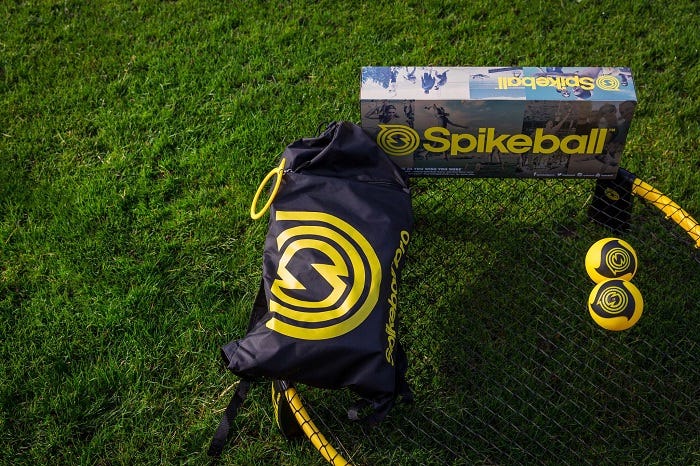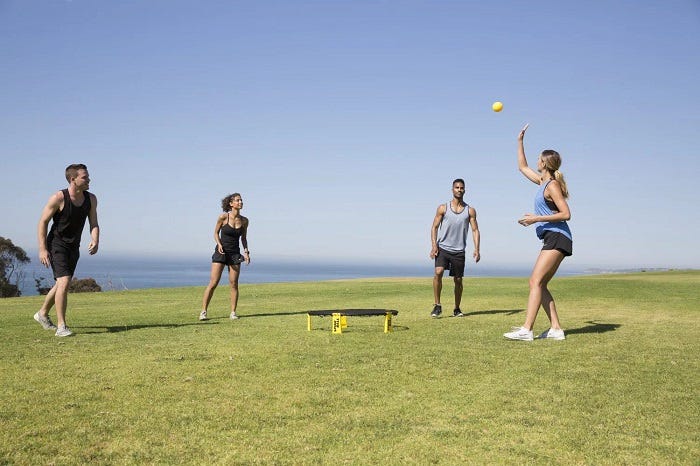How to use the Spikeball Set
SPIKEBALL: ORIGINS
The game was initially invented in Japan in 1989 and did gain some traction for around 6 years before but didn’t gain popularity again until around 2004/2005 when the now CEO of Spikeball Inc. purchased the patent for $800 and revamped the game to be what we know and love today.
HOW TO SET UP
Fit all of the rims into the legs until you have a fully complete circle with five rims and five legs all connected together with the legs sitting flat on the ground. The net can now be stretched around the hoop and be attached to the hooks on either side of the five legs. If you have the Spikeball Rookie set up, you should have an additional rim and leg to compensate for the 50% extra surface area to further enhance the user-friendly nature for any young or new users.

HOW TO PLAY
Once your spikeball net is readily assembled, the rules follow very similarly to Volleyball. The main difference would be the downward pass for the horizontal net of course. You can play with between 4 - 6 players in teams of two and the aim of the game is to serve in a way that makes it hard for the opposing team to serve the ball back. The teams line up across from each other with the net separating them. The three basic rules are players cannot carry the ball, players cannot hold the ball and only one hand can be used to touch the ball. The game will be played until one of the team fails to pass the ball, when the ball bounces more than once on the net or when a player double hits the ball - if none of these moves are made then the game is played out until the first team reaches 21 points.
SCORE SYSTEM
At every serve, one team gets a point based on the following rules:
- If the served ball hits the ground instead of the net, the opposing team gets 1 point
- If the ball hits the rim, the opposing team gets 1 point
- If the ball bounces off the net more than one time, the opposing team gets 1 point
- When the ball rolls on the net instead of bouncing off, the opposing team gets 1 point
- If one player catches the ball, carries it or throws it or simply handles it with 2 hands instead of hitting it, the opposing team gets 1 point
- If a player double touches the ball or hits it more than once in a row, the opposing team gets 1 point
- When a player makes a mistake twice in a row, the opposing team gets 1 point.
FAULT MOVES
- When serving the ball, the player needs to stay 6ft away from the net. If not, then this is considered a fault. If the server repeats it twice, the opposing team scores 1 point
- The server cannot serve the spikeball ball straight out of their hand. They need to toss the ball in the air at least 2 inches before they hit to serve
- Catching the ball, dropping, or missing a hit instead of hitting the ball at any time during the game will count as a fault. Two of these in a row earn your opposing team a point
- While serving, you can take one step ahead, but you cannot move sideways. This will be considered a fault
- Hitting the rim at any point of the game, while serving or playing, will count as a fault. Repeating this will earn your opposing team a point
- The players from one team should not block their opponents from getting to the ball. If this happens, they have to replay that part and should allow for the free flow of the ball.
When serving the ball, the server must pass the ball so that the opposing team is able to reach it without jumping for it. If the server hits it higher than the opponent’s outstretched arm, they will earn a fault - When the ball hits the net but then rolls to the rim during a serve instead of bouncing off to the opposing team, it is called a pocket. The pocket counts as a fault too.

ALTERNATIVE SET UPS
There are many different set ups for play depending on how many of you are getting stuck in. If you’re wondering if you can play spikeball with 2 or 3 players because you are short on people, I would say numbers shouldn’t stop you. Go for it! However, know that when played one-on-one, it’s a bit more challenging to get competitive. But luckily, you can make modifications in the rules so that the game is still interesting. For example, instead of only one, now each player has the right to 2 touches of the ball per possession in 2-player games. In a 3-player spikeball game, each player will play on their own against the other 2, and you all will need to follow a rotation in which each player gets its turn.
TRAVEL FRIENDLY
The size of the set allows you to disassemble it and travel with it anywhere you like. It’s all plastic, and when not assembled, it doesn’t take up too much space, so you can definitely take it with you no matter where you travel. It’s totally plane safe - even if you are only travelling with hand luggage, it packs away small enough to not be an issue (but it’s safest to check with your airline company just in case!).
COMPATIBLE APP
If you’re ever a player short or just bored of thrashing the same old chumps, there is an accompanying Spikeball app where you can create events, join local games and compete in tournaments. There is also a handy Learn section for any tips or how-to’s you may need, as well as a social feed where you can share your latest games’ action shots and clips. Of course, we always emphasise safety and awareness in all forms - including online. We recommend meeting online opponents with a friend and/or in a public place!

